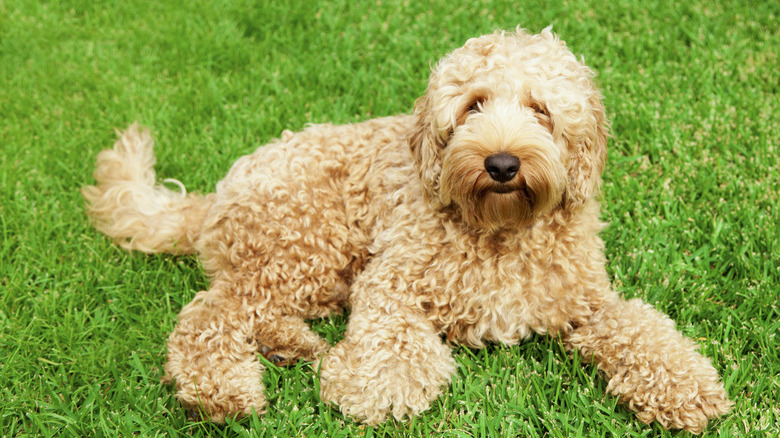How To Tell What A Lab Is Mixed With
The Labrador retriever has been a mainstay on the American Kennel Club's most registered dog for years, so it's no surprise that there are so many lab mixes in the world. Some lab mixes are by design, such as when crossed with a poodle to make a labradoodle, while others are happy accidents. Your observation skills can help you guess what your lab is mixed with, or you can use a scientific test to learn for sure, or even learn more if you are interested in how to breed Labradors.
Labrador original breed appearance
The Labrador retriever comes in three coat colors:
- Black.
- Yellow.
- Chocolate.
According to the AKC breed standard, the Labrador's dense, short, and straight coat is one of his distinctive features. He's a medium-size dog, standing between 21.5-and-24.5 inches tall, and weighing between 55-and-80 pounds. He has an athletic build and wide head with brown or hazel eyes, depending on his coat color.
Labrador temperament
The Labrador retriever is an intelligent, engaging dog who loves to be with her family, which may explain her enduring popularity. As an active dog, she enjoys participating in an array of activities, such as swimming, hiking, and jogging, and she won't mind working either. Labradors are known for their hunting, search and rescue, and sniffer-dog skills. She is an eager-to-please dog who responds very well to training.
Lab mix behavioral clues
If you pay close attention to your Lab mix's behavior, you might be able to gauge what type of dog he is. Dogs are often bred for certain behavioral traits. For example, herding dogs are bred for their ability to protect and move other animals, which often manifests in their day-to-day behavior and personality. Dog types and their behavior characteristics include:
- Protection dogs are usually dominant, confident, and responsive to training.
- Herding dogs tend to be dominant, demanding, sensitive, and anxious; with proper training, they're very obedient.
- Flocking dogs typically are confident, independent, tolerant, and protective and work well with people.
- Retrievers are often mouthy, energetic, happy dogs who excel in obedience.
- Scent hounds tend to be loving, sweet-natured dogs who often wander because they follow their noses.
- Sighthounds aren't unintelligent but usually are not too interested in pleasing their masters. They tend to be reserved and quiet when they're not giving chase.
- Terriers are independent, fun, and sometimes predatory because they are bred to chase prey.
- Spaniels were bred for hunting and used to flush game. Often, they're happy, energetic dogs who love to fetch.
- Pointers and setters are usually high-energy dogs who often possess sweet dispositions, though it can be challenging to teach them obedience.
- Northern breeds were often working dogs, pulling sleds and cargo. Usually, they have a strong prey drive and independent nature that leads them to wander.
- Fighting dogs were historically bred for aggressive purposes. Some dogs in this group may hold on to their aggressive tendencies. However, they're often affectionate, devoted dogs, though they also can be focused and prey-driven.
- Companion and toy dogs such as Dalmatians, bulldogs, and Chihuahuas will have characteristics associated with their specific breeds.
Watch your dog's behavior and note any behavior patterns. For instance, whether he's always sniffing and following a scent trail or is more interested in chasing squirrels. Understanding his personality traits will help you gauge what other breeds may be part of his genetic makeup.
Labrador mix physical clues
Pay attention to your dog's appearance and note any identifying features, such as:
- Ears: floppy or erect, rounded, or pointed.
- Tail: short, stubby, long, thin, wide, or bushy.
- Feet: more webbed or less webbed.
- Head: face, muzzle, eyes, and head shape.
- Coat: color, patterns, and hair type.
If your dog has the classic Lab coat but pointy ears, you can start considering dog breeds with prick ears, such as the German shepherd. A curly or wiry coat may indicate poodle genes. Size matters, too; a larger or smaller than normal Labrador mix can indicate the size of one of the parents.
DNA tests to determine breed
You can learn your dog's heritage by paying to have a deoxyribonucleic acid or DNA test done on your dog. Available online, many tests require a simple cheek swab from your dog, which is sent in to be analyzed against a database of a wide variety of dog breeds. If you choose to go with a DNA test, keep in mind that the more breeds the company offers in its database, the greater the odds of an accurate reading. Generally, the fewer the number of breeds in the dog, the greater the chance of identifying all of the dog's breeds.
